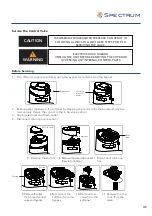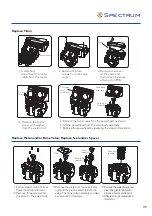
5
4
Spectrum
TM
2. Water Softener Basics
What is hard water and how it is softened
The majority of water comes from groundwater sources. Rain water permeates layers of soil, clay, sand
and rock and in the process picks up a number of minerals along the way.
Hardness is defined by the content of calcium and magnesium that is found in water. The harder the
water the more calcium and magnesium it contains. Although it is not toxic, hardness can cause a
number of problems.
Hard water leaves traces of calcium and magnesium on glassware, surfaces, within pipework and
appliances.
Which causes:
• Shorter equipment life span
• Higher energy costs
•
Reduced flow rates
• Under-performing appliances
Excess deposits create a drop in efficiency, increased chemical cleaning costs and maintenance schedules
and in the worse cases equipment failure.
Iron is a common water problem. The chemical/physical nature of iron found in natural water supplies is
exhibited in four general types:
1.
Dissolved Iron - Also called ferrous or ‘clear water’ iron. Dissolved iron is soluble in water and is
detected by taking a sample of the water to be treated in a clear glass. The water in the glass is initially
clear, but on standing exposed to the air, it may gradually turn cloudy or colored as it oxidizes. This type
of iron can be removed from the water by the same ion exchange principle that removes the hardness
elements, calcium and magnesium.
2.
Particulate Iron - Also called ferric or colloidal iron. This type of iron is an undissolved particle of iron. A
filtering treatment will be required to remove this type of iron. A softener will remove larger particles,
but the particles may not be washed out in regeneration effectively and will eventually foul the ion
exchange resin.
3. Organic bound Iron -This type of iron is strongly attached to an organic compound in the water. The ion
exchange process alone cannot break this bond down and the softener will not remove this type of iron.
4. Bacterial Iron-This type of iron is protected inside a bacteria cell. Like the organic bound iron, it is not
removed by a water softener.
It’s important that when a softener is removing both hardness and dissolved iron, it must regenerate
more frequently than it normally would for just hardness. Many factors and formulas have been used to
determine this frequency. It is recommended that the softener be regenerated when it has reached 50-75%
of the calculated hardness capacity. This will minimise the potential for bed fouling.
When operating a softener on water with less than the maximum of dissolved iron, regular cleaning should
be performed. Clean every six months or more often if iron appears in your conditioned water supply. Use
resin bed cleaning compounds carefully following the directions on the container.
DO NOT USE WATER THAT IS MICROBIOLOGICALLY UNSAFE
OR THE WATER IS OF UNKNOWN QUALITY. THE WATER MUST
BE DISINFECTED BEFORE OR AFTER THE UNIT.
CAUTION
Содержание SWS Series
Страница 2: ...2 ...
Страница 24: ...Spectrum TM ...




















